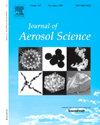调查植物燃烧产生的气溶胶的形态和成分
IF 3.9
3区 环境科学与生态学
Q2 ENGINEERING, CHEMICAL
引用次数: 0
摘要
在气候变化的推动下,野火的频率和强度在全球范围内显著增加,城市扩张扩大了野火对荒地-城市界面附近人口和结构的影响。植被火灾期间生物质燃烧产生复杂的气溶胶,通过吸入、摄入和皮肤接触造成潜在的健康风险。然而,对气溶胶形态、组成和行为的理解仍然不完整。本研究在模拟野火情景的受控实验室条件下,研究了地中海灌木山竹(Cistus monspeliensis)燃烧过程中排放的气溶胶。对1米高的灌木进行了全面燃烧,使用低压冲击器+捕获了真实的排放。收集了不同气动尺寸的气溶胶,并使用扫描电子显微镜和能量色散x射线光谱学进行了分析。颗粒主要分为四种类型:煤烟聚集体、粗粉煤灰、部分燃烧颗粒和凝聚颗粒,并对其形态和元素组成进行了广泛的表征。值得注意的是,在较小的气动级中,氯化钾凝聚物占主导地位,而在较大的气动级中,CFA的钙和镁含量较高。气溶胶大小和体积分布在燃烧过程中呈现动态变化,在热释放率(HRR)峰值前以纳米颗粒(43 nm气动直径)为主,在HRR峰值后以大颗粒(69 nm气动直径)为主。该研究还将颗粒的物理特性与其空气动力学行为联系起来,强调形状和密度在测量直径和空气动力学直径之间的差异中的作用。使用多路径粒子剂量学模型的沉积建模强调了潜在的健康风险,特别是在肺泡和气管支气管区域。通过整合形态、元素组成和大小分布,本研究为野火气溶胶的来源特征提供了重要的见解,增强了对其潜在健康影响的理解。这些发现有助于更广泛地模拟野火排放并为公共卫生战略提供信息,强调了在现实燃烧条件下研究气溶胶的重要性。本文章由计算机程序翻译,如有差异,请以英文原文为准。
Investigation of the morphology and composition of aerosols from plant burning
Wildfires have significantly increased in frequency and intensity worldwide, driven by climate change, with urban expansion amplifying their impact on populations and structures near the wildland-urban interface. Combustion of biomass during vegetation fires produces complex aerosols that pose potential health risks through inhalation, ingestion, and dermal exposure. However, the understanding of aerosol morphology, composition, and behaviour remains incomplete. This study investigates the aerosols emitted during the combustion of Cistus monspeliensis, a Mediterranean shrub, under controlled laboratory conditions simulating wildfire scenarios. A full-scale combustion of a 1-m-high shrub was performed, enabling the capture of realistic emissions using an Electrical Low-Pressure Impactor +.
Aerosols were collected across different aerodynamic size fractions and analysed using scanning electron microscopy and energy dispersive X-ray spectroscopy. Particles were classified into four main types: soot aggregates, coarse fly ash (CFA), partially burnt particles, and condensed particles, with their morphology and elemental composition extensively characterized. Notably, potassium chloride condensates dominated smaller aerodynamic stages, while CFA exhibited high calcium and magnesium content in larger stages. Aerosol size and volume distributions revealed dynamic variations during combustion, with nanoparticles (43 nm aerodynamic diameter) prevailing before the heat release rate (HRR) peak and larger particles (69 nm aerodynamic diameter) dominating after the peak HRR.
The study also links particle physical characteristics to their aerodynamic behaviour, emphasizing the role of shape and density in discrepancies between measured and aerodynamic diameters. Deposition modelling using the Multiple-Path Particle Dosimetry model highlights potential health risks, particularly in the alveolar and tracheobronchial regions.
By integrating morphology, elemental composition, and size distribution, this research provides crucial insights into the characteristics of wildfire aerosols at their source, enhancing the understanding of their potential health implications. These findings contribute to the broader effort to model wildfire emissions and inform public health strategies, emphasizing the importance of studying aerosols under realistic combustion conditions.
求助全文
通过发布文献求助,成功后即可免费获取论文全文。
去求助
来源期刊

Journal of Aerosol Science
环境科学-工程:化工
CiteScore
8.80
自引率
8.90%
发文量
127
审稿时长
35 days
期刊介绍:
Founded in 1970, the Journal of Aerosol Science considers itself the prime vehicle for the publication of original work as well as reviews related to fundamental and applied aerosol research, as well as aerosol instrumentation. Its content is directed at scientists working in engineering disciplines, as well as physics, chemistry, and environmental sciences.
The editors welcome submissions of papers describing recent experimental, numerical, and theoretical research related to the following topics:
1. Fundamental Aerosol Science.
2. Applied Aerosol Science.
3. Instrumentation & Measurement Methods.
 求助内容:
求助内容: 应助结果提醒方式:
应助结果提醒方式:


